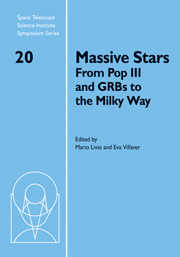Book contents
- Frontmatter
- Contents
- Participants
- Preface
- High-mass star formation by gravitational collapse of massive cores
- Observations of massive-star formation
- Massive-star formation in the Galactic center
- An x-ray tour of massive-star-forming regions with Chandra
- Massive stars: Feedback effects in the local universe
- The initial mass function in clusters
- Massive stars and star clusters in the Antennae galaxies
- On the binarity of Eta Carinae
- Parameters and winds of hot massive stars
- Unraveling the Galaxy to find the first stars
- Optically observable zero-age main-sequence O stars
- Metallicity-dependent Wolf-Rayet winds
- Eruptive mass loss in very massive stars and Population III stars
- From progenitor to afterlife
- Pair-production supernovae: Theory and observation
- Cosmic infrared background and Population III: An overview
Massive stars and star clusters in the Antennae galaxies
Published online by Cambridge University Press: 04 August 2010
- Frontmatter
- Contents
- Participants
- Preface
- High-mass star formation by gravitational collapse of massive cores
- Observations of massive-star formation
- Massive-star formation in the Galactic center
- An x-ray tour of massive-star-forming regions with Chandra
- Massive stars: Feedback effects in the local universe
- The initial mass function in clusters
- Massive stars and star clusters in the Antennae galaxies
- On the binarity of Eta Carinae
- Parameters and winds of hot massive stars
- Unraveling the Galaxy to find the first stars
- Optically observable zero-age main-sequence O stars
- Metallicity-dependent Wolf-Rayet winds
- Eruptive mass loss in very massive stars and Population III stars
- From progenitor to afterlife
- Pair-production supernovae: Theory and observation
- Cosmic infrared background and Population III: An overview
Summary
Large numbers of young stars are formed in merging galaxies, such as the Antennae galaxies. Most of these stars are formed in compact star clusters (i.e., super star clusters), which have been the focus of a large number of studies. However, an increasing number of projects are beginning to focus on the individual stars as well. In this contribution, we examine a few results relevant to the triggering of star and star cluster formation; ask what fraction of stars form in the field rather than in clusters; and begin to explore the demographics of both the massive stars and star clusters in the Antennae.
Introduction
It is now well accepted that most star formation occurs in clustered environments, such as associations, groups and clusters (e.g., Lada & Lada 2003). In addition, it is clear that star formation is greatly enhanced in merging galaxies, making them an excellent place to study the formation of large numbers of young, massive stars—albeit with the disadvantage of having to work with stars at larger distances than the nearby groups and clusters in our own galaxy. In keeping with their galactic counterparts, most of the stars in merging galaxies also form in clusters, the brightest and most compact of which have been dubbed “super star clusters.” Hence, understanding what triggers the formation of star clusters in mergers may be an important clue for understanding the formation of stars in general.
- Type
- Chapter
- Information
- Massive StarsFrom Pop III and GRBs to the Milky Way, pp. 104 - 115Publisher: Cambridge University PressPrint publication year: 2009
- 1
- Cited by



